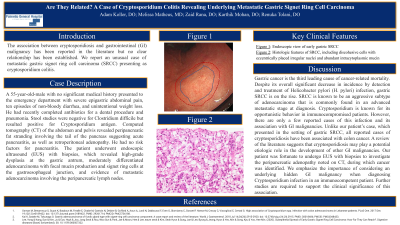Back


Poster Session E - Tuesday Afternoon
Category: Stomach
E0717 - Are They Related? A Case of Cryptosporidium Colitis Revealing an Underlying Metastatic Gastric Signet Ring Cell Carcinoma
Tuesday, October 25, 2022
3:00 PM – 5:00 PM ET
Location: Crown Ballroom

Has Audio
.jpg)
Adam Z. Koller, DO, MS
Palmetto General Hospital
Hialeah, FL
Presenting Author(s)
Adam Z. Koller, DO, MS1, Melissa Matheus, MD1, Zaid Rana, DO2, Karthik Mohan, DO1, Renuka Tolani, DO3
1Palmetto General Hospital, Hialeah, FL; 2Larkin Community Hospital, Hialeah, FL; 3Palmetto Genreal Hospital, Hialeah, FL
Introduction: The association between cryptosporidiosis and gastrointestinal (GI) malignancy has been reported in the literature but no clear relationship has been established. We report an unusual case of metastatic gastric signet ring cell carcinoma (SRCC) presenting as cryptosporidium colitis.
Case Description/Methods: A 55-year-old-male with no significant medical history presented to the emergency department with severe epigastric abdominal pain, ten episodes of non-bloody diarrhea, and unintentional weight loss. He had recently completed antibiotics for a dental procedure and pneumonia. Stool studies were negative for Clostridium difficile but resulted positive for Cryptosporidium antigen. Computed tomography (CT) of the abdomen and pelvis revealed peripancreatic fat stranding involving the tail of the pancreas suggesting acute pancreatitis, as well as retroperitoneal adenopathy. He had no risk factors for pancreatitis. The patient underwent endoscopic ultrasound (EUS) with biopsies, which revealed high-grade dysplasia at the gastric antrum, moderately differentiated adenocarcinoma with focal mucin production and signet ring cells at the gastroesophageal junction, and evidence of metastatic adenocarcinoma involving the peripancreatic lymph nodes.
Discussion: Gastric cancer is the third leading cause of cancer-related mortality. Despite its overall significant decrease in incidence by detection and treatment of Helicobacter pylori (H. pylori) infection, gastric SRCC is on the rise. SRCC is known to be an aggressive subtype of adenocarcinoma that is commonly found in an advanced metastatic stage at diagnosis. Cryptosporidium is known for its opportunistic behavior in immunocompromised patients. However, there are only a few reported cases of this infection and its association with GI malignancies. Unlike our patient’s case, which presented in the setting of gastric SRCC, all reported cases of cryptosporidiosis have been associated with colon cancer. A review of the literature suggests that cryptosporidiosis may play a potential etiologic role in the development of other GI malignancies. Our patient was fortunate to undergo EUS with biopsies to investigate the peripancreatic adenopathy noted on CT, during which cancer was identified. We emphasize the importance of considering an underlying hidden GI malignancy when diagnosing Cryptosporidium infection in an immunocompetent patient. Further studies are required to support the clinical significance of this association.
Disclosures:
Adam Z. Koller, DO, MS1, Melissa Matheus, MD1, Zaid Rana, DO2, Karthik Mohan, DO1, Renuka Tolani, DO3. E0717 - Are They Related? A Case of Cryptosporidium Colitis Revealing an Underlying Metastatic Gastric Signet Ring Cell Carcinoma, ACG 2022 Annual Scientific Meeting Abstracts. Charlotte, NC: American College of Gastroenterology.
1Palmetto General Hospital, Hialeah, FL; 2Larkin Community Hospital, Hialeah, FL; 3Palmetto Genreal Hospital, Hialeah, FL
Introduction: The association between cryptosporidiosis and gastrointestinal (GI) malignancy has been reported in the literature but no clear relationship has been established. We report an unusual case of metastatic gastric signet ring cell carcinoma (SRCC) presenting as cryptosporidium colitis.
Case Description/Methods: A 55-year-old-male with no significant medical history presented to the emergency department with severe epigastric abdominal pain, ten episodes of non-bloody diarrhea, and unintentional weight loss. He had recently completed antibiotics for a dental procedure and pneumonia. Stool studies were negative for Clostridium difficile but resulted positive for Cryptosporidium antigen. Computed tomography (CT) of the abdomen and pelvis revealed peripancreatic fat stranding involving the tail of the pancreas suggesting acute pancreatitis, as well as retroperitoneal adenopathy. He had no risk factors for pancreatitis. The patient underwent endoscopic ultrasound (EUS) with biopsies, which revealed high-grade dysplasia at the gastric antrum, moderately differentiated adenocarcinoma with focal mucin production and signet ring cells at the gastroesophageal junction, and evidence of metastatic adenocarcinoma involving the peripancreatic lymph nodes.
Discussion: Gastric cancer is the third leading cause of cancer-related mortality. Despite its overall significant decrease in incidence by detection and treatment of Helicobacter pylori (H. pylori) infection, gastric SRCC is on the rise. SRCC is known to be an aggressive subtype of adenocarcinoma that is commonly found in an advanced metastatic stage at diagnosis. Cryptosporidium is known for its opportunistic behavior in immunocompromised patients. However, there are only a few reported cases of this infection and its association with GI malignancies. Unlike our patient’s case, which presented in the setting of gastric SRCC, all reported cases of cryptosporidiosis have been associated with colon cancer. A review of the literature suggests that cryptosporidiosis may play a potential etiologic role in the development of other GI malignancies. Our patient was fortunate to undergo EUS with biopsies to investigate the peripancreatic adenopathy noted on CT, during which cancer was identified. We emphasize the importance of considering an underlying hidden GI malignancy when diagnosing Cryptosporidium infection in an immunocompetent patient. Further studies are required to support the clinical significance of this association.
Disclosures:
Adam Koller indicated no relevant financial relationships.
Melissa Matheus indicated no relevant financial relationships.
Zaid Rana indicated no relevant financial relationships.
Karthik Mohan indicated no relevant financial relationships.
Renuka Tolani indicated no relevant financial relationships.
Adam Z. Koller, DO, MS1, Melissa Matheus, MD1, Zaid Rana, DO2, Karthik Mohan, DO1, Renuka Tolani, DO3. E0717 - Are They Related? A Case of Cryptosporidium Colitis Revealing an Underlying Metastatic Gastric Signet Ring Cell Carcinoma, ACG 2022 Annual Scientific Meeting Abstracts. Charlotte, NC: American College of Gastroenterology.
